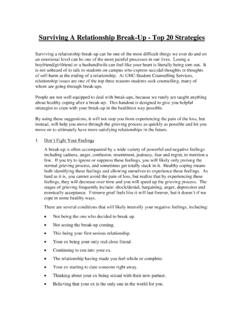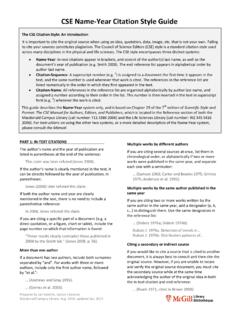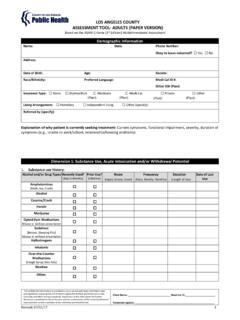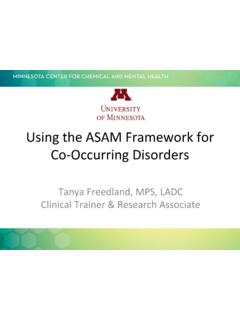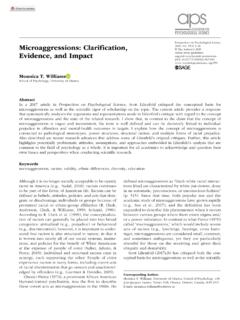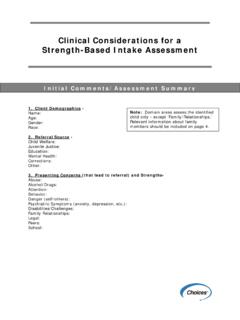Transcription of Diagnostic Criteria for Relational Problems
1 1 Diagnostic Criteria for Relational Problems Table of Contents Diagnostic Criteria for Partner Physical Abuse ..2 Diagnostic Criteria for Partner Emotional Abuse ..3 Diagnostic Criteria for Partner Sexual Abuse ..4 Diagnostic Criteria for Partner Neglect ..5 Diagnostic Criteria for Child Physical Abuse ..6 Diagnostic Criteria for Child Emotional Abuse ..7 Diagnostic Criteria for Child Sexual Abuse ..8 Diagnostic Criteria for Child Neglect ..9 Diagnostic Criteria for Partner Relational problem ..10 Diagnostic Criteria for Parenting problem ..11 Diagnostic Criteria for Parent-Child Relational problem ..12 Criteria for More Than Inconsequential Fear Reaction ..13 Criteria for More Than Inconsequential Physical Injury ..13 Criteria for Protection of self from Imminent Physical Harm Because Other Was in the Act of Physical Force ..14 Criteria for Protection of self from Imminent Physical Harm Because of Partner s Threat.
2 14 Criteria for Sex Act ..14 2 Diagnostic Criteria for Partner Physical Abuse A. Non-accidental use of physical force. Physical force includes, but is not limited to, pushing; shoving; slapping; grabbing; poking; hair-pulling; scratching; pinching; restraining; shaking; throwing; biting; kicking; hitting with fist; hitting with a stick, strap, or other object; scalding; burning; poisoning; stabbing; applying force to throat; cutting off air supply; holding under water; using a weapon. B. Significant impact on the victim as evidenced by any of the following: (1) Any physical injury (including, but not limited to, pain that lasts at least four hours, bruises, cuts, sprains, broken bones, loss of consciousness) (2) Reasonable potential for more than inconsequential physical injury (see p. 13) given the inherent dangerousness of the act, the degree of force used and the physical environment in which the acts occurred (3) More than inconsequential fear reaction (see p.)
3 13) C. The acts of physical force were not committed for any of the following reasons: (1) To protect self from imminent physical harm because the partner was in the act of physical force (see p. 14) (2) To protect self from imminent harm because of partner s threat (see p. 14) and history of inflicting more than inconsequential physical injury (see p. 13) (3) To play with the partner (4) To protect partner or another person from imminent physical harm (including, but not limited to, pushing partner out of the way of a car, taking weapon away from suicidal partner, stopping partner from inflicting injury on child). Note: Subsequent actions that were not directly protective ( , smacking partner for making suicidal gesture) would not meet this criterion. 3 Diagnostic Criteria for Partner Emotional Abuse A. Verbal or symbolic acts (excluding physically aggressive acts [see p.]
4 2, Criterion A] and sexually abuse [see p. 4]) with the potential to cause psychological harm to the victim. Such acts include, but are not limited to, (1) Berating, disparaging, degrading, humiliating partner (2) Interrogating partner (3) Restricting partner s ability to come and go freely (when unwarranted) (4) Obstructing partner s access to assistance (including, but not limited to, law enforcement, legal, protective, or medical resources) (5) Threatening partner (including, but not limited to, indicating/implying future physical harm, sexual assault) (6) Harming, or threatening to harm, people/things that partner cares about, such as children, self , other people, pets, property (7) Restricting partner s access to or use of economic resources (when unwarranted). Warranted restrictions involve obstructing a partner from behaviors that may injure self or others ( , taking an intoxicated partner s car keys) or obstructing a recklessly-spending partner from incurring debts despite an obviously grave economic situation ( , impending bankruptcy).
5 Restrictions not meeting these rare circumstances would be considered unwarranted. (8) Isolating partner from family, friends, or social support resources (9) Stalking partner (10) Trying to make partner think that s/he is crazy (or make others think that partner is crazy) B. Significant impact on the victim as evidenced by any of the following: (1) Psychological harm, including any of the following a. More than inconsequential fear reaction (see p. 13) b. Significant psychological distress ( , psychiatric disorders, at or near Diagnostic thresholds) related to, or exacerbated by, the act(s) c. Fear of emotionally abusive act(s) that significantly interfere(s) with the victim s ability to carry out any of these five major life activities i. work ii. education iii. religion iv. necessary medical or mental health services v. contact with family/friends (2) Stress-related somatic symptoms (related to or exacerbated by the acts) that significantly interfere with normal functioning.
6 4 Diagnostic Criteria for Partner Sexual Abuse Any of the following acts committed by a partner in a current or former romantic relationship A. The use of physical force to compel participation in a sex act (see p. 14) against the victim s will, whether or not the act is completed. B. The use of a physical force or an emotionally aggressive act (see pg. 3, Criterion A) to coerce the victim to participate in a sex act (see p. 14). C. An attempted or completed sex act (see p. 14) when the victim is unable to provide consent for the following reasons: (1) Victim is unable to understand the nature or conditions of the act or to decline participation (2) Victim cannot communicate unwillingness to engage in the sexual act ( , due to illness; disability; being asleep or under the influence of alcohol or other drugs). D. Physical contact of a sexual nature (including, but not limited to, kissing, groping, rubbing, fondling directly or through clothing) that meets both of the following: (1) The contact is against the expressed wishes of the partner (2) The contact causes considerable distress to the partner that lasts for more than 24 hours.
7 Considerable distress involves anguish that does not necessarily meet Diagnostic thresholds for psychiatric disorders but exceeds distress incurred in normal, day-to-day activities. 5 Diagnostic Criteria for Partner Neglect A. One partner is incapable of self care due to substantial limitations in one or more of the following areas: (1) Physical (including, but not limited to, quadriplegia) (2) Psychological/intellectual (including, but not limited to, vegetative depression, very low IQ, psychosis) (3) Cultural (including, but not limited to, inability to communicate, inability to manage activities of rudimentary daily living due to foreign culture) B. Deprivation-related significant impact on the incapable partner due to act(s) or omission(s) by the capable partner. Deprivation involves the withholding of, or withholding access to, adequate food, shelter, hygiene, or necessary medical/psychiatric services and/or gross negligence regarding the safety needs of the incapable partner.
8 Deprivation-related significant impact involves either of the following: (1) More than inconsequential physical injury (see p. 13) resulting from capable partner s acts or omissions (2) Reasonable potential for more than inconsequential physical injury (see p. 13) 6 Diagnostic Criteria for Child Physical Abuse A. Non-accidental use of physical force by a child s parent/caregiver. Physical force includes, but is not limited to, spanking with hand; dropping; pushing; shoving; slapping; grabbing; poking; hair-pulling; scratching; pinching; restraining; shaking; throwing; biting; kicking; hitting with fist; hitting with a stick, strap, or other object; scalding; burning; poisoning; stabbing; applying force to throat; cutting off air supply; holding under water; using a weapon. B. Significant impact on the child as evidenced by any of the following: (1) More than inconsequential physical injury (see p.)
9 13) (2) Reasonable potential for more than inconsequential physical injury (see p. 13) given the inherent dangerousness of the act, the degree of force used and the physical environment in which the acts occurred (3) More than inconsequential fear reaction (see p. 13) C. The acts of physical force were not committed for any of the following reasons: (1) To protect self from imminent physical harm because the child/adolescent was in the act of physical force (see p. 14) (2) To play with the child in a developmentally appropriate manner (3) To protect child or another person from imminent physical. Note: Subsequent actions that were not directly protective ( , whipping child for running into the street) would not meet this criterion. 7 Diagnostic Criteria for Child Emotional Abuse A. Verbal or symbolic act or acts (excluding physical abuse [see p.]
10 6] and sexually abuse [see p. 8]) by a parent/caregiver with the potential to cause psychological harm to the child. Such acts include, but are not limited to, (1) Berating, disparaging, degrading, humiliating child (2) Threatening child (including, but not limited to, indicating/implying future physical harm, abandonment, sexual assault) (3) Harming/abandoning or indicating that the parent/caregiver will harm/abandon people/things that child cares about, such as pets, property, loved ones (including exposing child to Criteria -meeting or subthreshold partner maltreatment) (4) Confining child (a means of punishment involving restriction of movement, as by tying a child s arms or legs together or binding a child to a chair, bed, or other object, or confining a child to an enclosed area [such as a closet]) (5) Egregious scapegoating of child (6)


